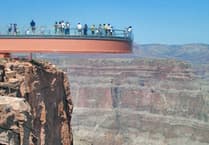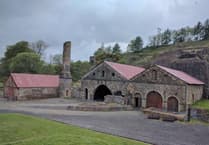NEW and improved footpaths at a popular beauty spot have been approved – but there is no decision on installing cattle grids following a dog’s death.
The seven-year-old dog died in April last year after getting its foot caught in a cattle grid installed as part of a trial related to the new routes at Castle Meadows in Abergavenny.
As a result a planning application to approve the new routes, paths and access points was withdrawn at the eleventh hour when they were due to be considered by councillors just days after the tragic accident.
When the plans were put back before Monmouthshire County Council’s planning committee on Tuesday, February 6, councillors were only asked to approve the improvements to the existing routes and new paths and a replacement of the existing footbridge over the river Gavenny.
Planning officer Andrew Jones said the access points, including the potential use of cattle grids, would be decided under permitted development rights, with the county council, which has made the application, continuing talks with Transport for Wales which has responsibility for active travel walking and cycling routes.
Grofield county councillor Laura Wright, who said she regularly walks her dog, Shadow, at the Meadows – five minutes from her home – told the committee that Jo Waters whose schnoodle Eva – a schnauzer and poodle cross – died after getting trapped in the grid was among the members of the public present in the chamber at County Hall in Usk.
“Her dog died on the trial grid. I saw it happen and it was so distressing,” said the Labour councillor who added she didn’t believe the committee could avoid any discussion of the cattle grids.
While she said she supported the application, and improving accessibility to and across the Meadows, Cllr Wright asked if the committee would pause its decision making until there is confirmation cattle grids wouldn’t be used.
The councillor also welcomed the decision to use a permeable resin buff surface for the three metre wide paths, rather than tarmac as originally proposed: “I stood for election and vowed to stop any use of tarmac on the Meadows and I’m pleased that is the case.”
Andrew Erskin, of the Abergavenny Active Group and Friends of Castle Meadows, said it also supported the principle of the scheme but had concerns about cattle grids which he said were only included so cyclists, who he said make up just two per cent of the half a million people that pass through the area every year, wouldn’t have to stop.
“Cattle grids are contentious and should be subject to the approval of this committee,” said Mr Erskin who added: “Cyclists have to stop at road junctions so why shouldn’t they here?”
David Haswell, of the Abergavenny Development Forum, said it has supported the scheme since the new bridge over the Usk and a busy road, linking the Meadows with Llanfoist and which has already been approved, was proposed in 2018. But he said it disagreed with the proposed routes which he said were not the most direct.
He also asked the committee to delay any decision to “create some time for a bit of earnest tweaking”.
Cyclist and local mum Samantha Meurig submitted a video submission outlining her “100 per cent support” for the plans as she said they create a safe route between Llanfoist and Abergavenny.
She said fears of “an influx of recreational cyclists” were unfounded: “The Meadows is already part of the national cycle network and they aren’t currently using the Meadows because they are out for long recreational rides not small journeys in the local area.”
Paul Sullivan, Monmouthshire council’s active travel manager, said it is in “ongoing discussions with Transport for Wales on both grid and non grid access points”.
Planning committee member, Goytre Fawr, Conservative councillor Jan Butler said: “A member of my family now relies on a mobility scooter and is not able to access the walks we used to be able to, so I really do welcome the proposal.”
Mr Jones said there were no objections from the council’s ecology officer or Natural Resources Wales, which also said it was satisfied any flooding risk could be managed and that routes had been selected for a variety of reasons including safety and ecology.
The application was approved with 12 votes in favour and one abstention.




